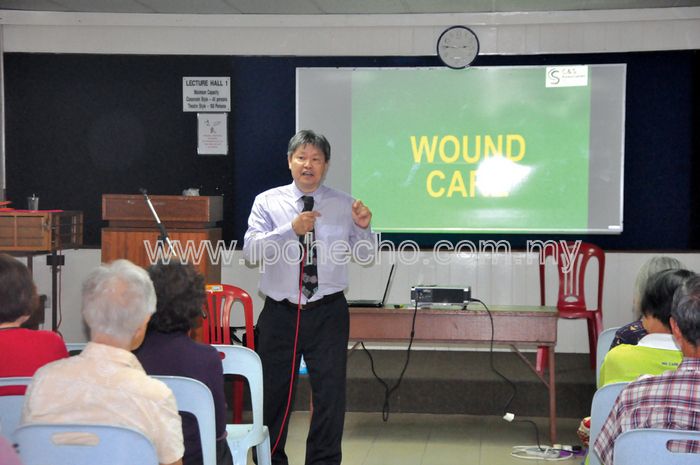

A wound, by definition, is a breakdown in the protective function of the skin, the loss of continuity of epithelium, with or without loss of underlying connective tissue following injury to the skin or underlying tissues or organs caused by surgery, a blow, a cut, chemicals, heat or cold.
A talk on wound care, especially pressure sores at nursing homes, was held on Saturday, April 8 at the YMCA hall, Ipoh.
“I started my nursing career 25 years ago in Singapore. When I returned to Malaysia later on, I was shocked by what I saw at a nursing home. The standard of care delivered was poor. The wound management practised at the home was already banned in Singapore,” said Cecilia Chan.


Simon Lam and Cecilia Chan are both directors of C & S Associates Aged Care Consultancy and Training. Simon, a nurse, has presented papers in Australia and UK while Cecilia is currently doing a PhD research on ageing in place in Malaysia.
“In Singapore and other advanced countries, the wound management team, headed by a nurse practitioner, is the one who treats the wounds. Over here, it’s done in a ward. When more cases are referred to me, I feel compelled to share with as many people as possible. A lot of these cases, at very advanced stage, can be prevented and should not have happened in the first place. With proper management, wounds can heal without much suffering and anxiety.”
“Wound management must be an evidence-based practice. One, it must have a moist wound bed environment. Research has proven over the last 30 years moist wound healing heals faster by up till 30 per cent than dry wounds. Two, nutritional status is important. Three, the removal of dead tissues and exudates. Four, your wound site must be pH neutral. And five, it must be free of infection,” Simon stated.
According to Simon, one of the extrinsic factors that affects wound healing is repetitive trauma. Hence, wound dressing need not be done every day, as it’ll re-traumatise the wound bed. Other extrinsic factors include heat, unrelieved pressure, bad care, inappropriate wound management and toxicity of antiseptics on wound.
On the principles of wound management, he had this to say, “The less we disturb a wound during dressing change, the lower the interference to healing. Cleansing should be performed in a way that minimises trauma to the wound. Wounds are best cleansed with isotonic saline. Antiseptic solutions should not be used to clean wounds routinely. Dressings must conform to wound beds and must be non-adherent.”
For more information, readers can email Simon at simonlam@optusnet.com.au or Cecilia at cejosh@yahoo.com.
Mei Kuan


